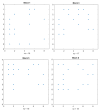Coefficient-Shuffled Variable Block Compressed Sensing for Medical Image Compression in Telemedicine Systems
- PMID: 39593760
- PMCID: PMC11591450
- DOI: 10.3390/bioengineering11111101
Coefficient-Shuffled Variable Block Compressed Sensing for Medical Image Compression in Telemedicine Systems
Abstract
Medical professionals primarily utilize medical images to detect anomalies within the interior structures and essential organs concealed by the skeletal and dermal layers. The primary purpose of medical imaging is to extract image features for the diagnosis of medical conditions. The processing of these images is indispensable for evaluating a patient's health. However, when monitoring patients over extended periods using specific medical imaging technologies, a substantial volume of data accumulates daily. Consequently, there arises a necessity to compress these data in order to remove duplicates and speed up the process of acquiring data, making it appropriate for effective analysis and transmission. Compressed Sensing (CS) has recently gained widespread acceptance for rapidly compressing images with a reduced number of samples. Ensuring high-quality image reconstruction using conventional CS and block-based CS (BCS) poses a significant challenge since they rely on randomly selected samples. This challenge can be surmounted by adopting a variable BCS approach that selectively samples from diverse regions within an image. In this context, this paper introduces a novel CS method that uses an energy matrix, namely coefficient shuffling variable BCS (CSEM-VBCS), tailored for compressing a variety of medical images with balanced sparsity, thereby achieving a substantial compression ratio and good reconstruction quality. The results of experimental evaluations underscore a remarkable enhancement in the performance metrics of the proposed method when compared to contemporary state-of-the-art techniques. Unlike other approaches, CSEM-VBCS uses coefficient shuffling to prioritize regions of interest, allowing for more effective compression without compromising image quality. This strategy is especially useful in telemedicine, where bandwidth constraints often limit the transmission of high-resolution medical images. By ensuring faster data acquisition and reduced redundancy, CSEM-VBCS significantly enhances the efficiency of remote patient monitoring and diagnosis.
Keywords: block compressive sensing; coefficient shuffling; compressive sensing; medical imaging; telemedicine.
Conflict of interest statement
The authors declare no conflict of interest.
Figures





References
-
- Cabral T.W., Khosravy M., Dias F.M., Monteiro H.L.M., Lima M.A.A., Silva L.R.M., Naji R., Duque C.A. Sensors for Health Monitoring. Elsevier; Amsterdam, The Netherlands: 2019. Compressive sensing in medical signal processing and imaging systems; pp. 69–92.
-
- Monika R., Dhanalakshmi S. An efficient medical image compression technique for telemedicine systems. Biomed. Signal Process. Control. 2023;80:104404. doi: 10.1016/j.bspc.2022.104404. - DOI
-
- Hosny K.M., Khalid A.M., Mohamed E.R. Efficient compression of bio-signals by using Tchebichef moments and Artificial Bee Colony. Biocybern. Biomed. Eng. 2018;38:385–398. doi: 10.1016/j.bbe.2018.02.006. - DOI
Grants and funding
LinkOut - more resources
Full Text Sources

